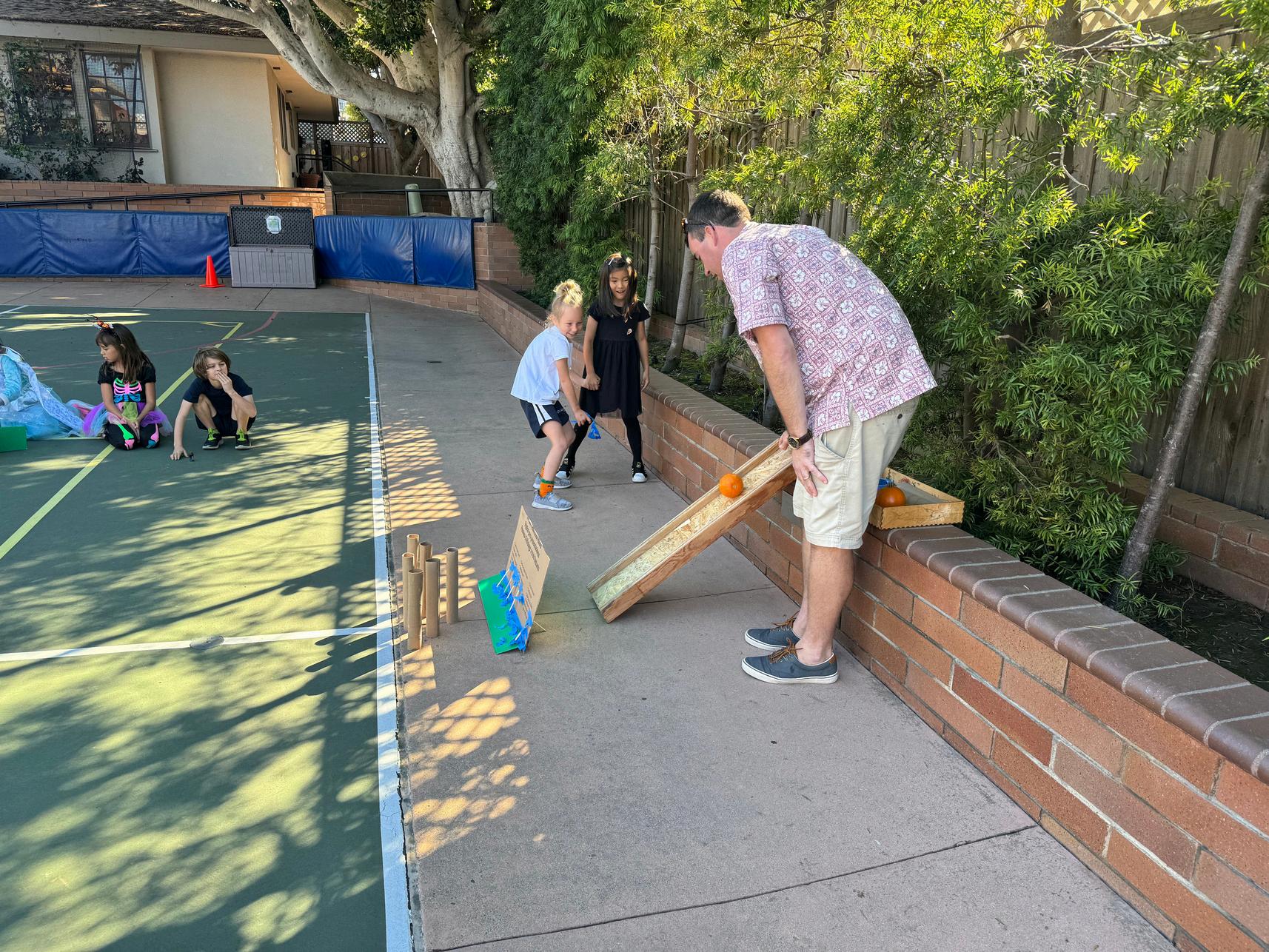
A NEWSLETTER FROM GILLISPIE’S LEARNING VILLAGE IN LA JOLLA.




DR. MINDY COATES SMITH, DIRECTOR OF EARLY CHILDHOOD
With winter break just around the corner, let’s take a moment to appreciate the simple joys and meaningful connections that enrich our lives.
Gratitude is a powerful skill that grows with awareness and practice. At Gillispie, we’ve seen how it transforms relationships and enhances the well-being of our students. Gratitude helps us better understand ours as well as others’ experiences.
While we often associate gratitude with saying “thank you,” it’s much more than that! When we intentionally use gratitude to shape how we approach each day, we cultivate empathy, reduce stress, and strengthen our sense of community. Let’s ask ourselves:
SPECIALTY SPOTLIGHT BOOKS FOSTER EMOTIONAL CONNECTION
p. 2-3
INNOVATION CORNER ROLLING WITH A PUMPKIN ATTITUDE p 4
HAPPY HAPPENINGS IN EARLY CHILDHOOD THE POWER OF CHOICE p 6
ICARE LEADING WITH GRATITUDE P. 7
COMMUNITY BE-LEAF IN YOURSELF! p. 8

(cont’d)
What are we grateful for today? What are we grateful to be? What do we look forward to with gratitude in the future?
Here are a few ways to practice gratitude with your family:
Start a Gratitude Routine: Add gratitude to daily activities, like brushing your teeth.
Use a Gratitude Jar: Write down what your family is grateful for and collect the notes in a jar.
Read Gratitude-Themed Books: Share stories that inspire gratitude together.
This holiday season let’s recognize the good in ourselves, each other, and the world around us. Let’s pause, consider other perspectives, and act with empathy. Isn’t that the kind of world that we want our children to live in?
HEIDI LONG, M.ED., LIBRARIAN
Gratitude is not only the greatest of virtues but the parent of all others. – Cicero
Children’s books are powerful tools to engage imagination and emotion.
Research shows that engaging children’s imaginations builds their cognitive skills, espec those related to understanding others’ though feelings. Sharing stories sparks children’s imaginations. Studies also show that when rea emotionally connect to fiction, their empathy



increases With empathy, w understand the efforts and
As caring adults, we know th teaching our children gratit skill that helps us appreciate all of the good things in our nurture a child’s sense of th reading together.
Matt de la Peña’s modern cl Market Street, teaches us gra boy disparages his surround grandmother encourages hi good. An uplifting ode to co the story ends with the pair soup kitchen.




Similarly, Oge Mora’s award-winning picture book, Thank You, Omu!, provides a beautiful lesson in gratitude. In this story, Omu offers
the story’s message and how it applies to their own experiences These conversations can help foster a lasting attitude of gratitude

BRIAN BELSHA AND CHIP EDWA
In the spirit of the season, Gilli graders tackled the annual “Ru Pumpkin” project an engagin inspired by Kevin Lewis’ book, Pumpkin. The story is about tw whose perfect Halloween pum control, causing chaos in their the mishap, they find joy in ima delicious dishes their grandmo with the smashed pumpkin.
This tale was the basis of a cro iterative project where studen with designing a pumpkin stop their polka-dot pumpkin from paper towel tube “village.”
Students began by engaging w gaining a big-picture view: des building a pumpkin stopper. Th y questions to clarify constraints, such as “What materials can we use?” and “How big is the pumpkin?” questions that informed their brainstorming and design phases.

Given one 18x24-inch cardboard piece, five popsicle sticks, and blue tape, students had to work within set constraints, like only using tape for attaching materials and not securing their stopper to the ground
Students sketched initial designs independently or in pairs, then had a lesson on cutting and attaching materials to reduce waste. On Halloween, students tried their pumpkin stoppers to see how well their first designs protected the village. After these initial runs, students re-entered the engage and clarify phases, assessing successes and redesigning for the next round of testing.


In addition, this project also featured a multifaceted art component where students read Yayoi Kusama Covered Everything in Dots and Wasn't Sorry by Fausto Gilberti, then went on a field trip to MCASD in La Jolla to see Kusama’s Dreaming Pumpkin Inspired by Kusama’s style, students created their own polka-dot pumpkins, for the final pumpkin stopper trials.
This cross-disciplinary project required students to apply Gillispie’s Design Thinking Model (see our diagram) and an innovator’s mindset, characterized by curiosity, creativity, empathy, ethical problem-solving, resilience, critical thinking, and learning from mistakes
Perhaps the greatest lesson of all was seeing students embrace Attitude, one of Gillispie’s ICARE Values. After each iteration, they returned to their projects to improve their designs, leaning on their “pumpkin” attitudes to turn setbacks into learning opportunities and build perseverance This project was a wonderful way to practice and employ Gillispie’s Attitude value and, of course, who doesn’t enjoy rolling pumpkins down a ramp to see if they’ll crash into a village?




MS. HURLEY AND MS. WEAR, GRADE 3 TEACHERS
Gillispie’s third graders have been on a journey of self-discovery and collaboration through an “Academic Choice” social studies project, inspired by the Responsive Classroom model.
Students were tasked with creating a project to show their understanding of social studies terms Key concepts that were explored by the students:
Physical Features: Learning about landforms like mountains, valleys, and plateaus, along with climate zones such as deserts, tropical, temperate, and polar regions.
Human-Made Features: Examining transportation systems, including roads, railways, waterways, and airways.


Students customized their projects to their learning styles, opting to illustrate stories, designing maps or games, creating picture dictionaries, developing matching games or quizzes, compiling Book Creator projects, or designing murals. They also created fictional maps with titles, legends, scales, and compass roses or wrote stories about journeys through diverse landscapes.
Empowering students to choose their own projects fostered a growth mindset, inspiring them to work diligently and value diverse perspectives. This approach allowed students to take ownership of their learning.
This “Academic Choice” project not only boosted educational achievement but also cultivated essential life skills such as teamwork, responsibility, inclusion, and positivity.






SARA JOHNSTON, SCHOOL COUNSELOR
Gillispie’s No Place for Hate student committee is working to promote acceptance, respect, and inclusion within our school community.
Recently, committee members have been discussing their group promises and goals while reflecting on their hopes and dreams for the year. Through thoughtful reflections, they’ve expressed a shared passion for kindness and inclusion, sparking deeper conversations about what inclusion looks, sounds, and feels like. They’re now exploring how gratitude can be a powerful way to promote these values in our community
In our school and beyond, gratitude takes many forms:
A friend expressing gratitude for receiving help in a class strengthens relationships by helping others feel valued and seen. A classmate recognizing the contributions of another classmate in a disagreement promotes empathy, breaking down social barriers.
A teacher recognizing a team for a job well done, makes students feel appreciated. They’re then more likely to reach out, include others, and work together

And the benefits of gratitude extend beyond our campus! Families can try sharing something they’re grateful for each day, keeping a family gratitude journal, or encouraging children to thank a kind peer. Together, we can use gratitude as a foundation for inclusion.
Book Recommendations:
The Thankful Book by Todd Parr Thankful by Eileen Spinelli
The Secret Of Saying Thanks by Douglas Wood
We Are Grateful: Otsaliheliga by Traci Sorell







ThebulletinboardattheECFayentrancehasa beautifuldisplaycalled“Be-LeafinYourself!” There’snodoubtthatapositiveattitudeand healthyself-esteemarevitaltoachild’s growth.
Inourpreschoolprogram,childrenare encouragedtotakeonchallengesandconquer fears,andeveryattempt,whethersuccessful ornot,ismetwithpositivereinforcement, buildingourstudentscompetenceand resilience.
Childrenbuildself-esteemwhen: Theyengageinplaygroundactivitieslike climbing,balancing,andnavigating obstaclecourses Eachaccomplishment reinforcestheirconfidenceand



encourages them to take on new challenges both on and off the playground. They choose and complete classroom jobs. Selecting their own responsibilities gives them control and ownership, while positive feedback strengthens their sense of accomplishment, motivating them to embrace new tasks daily
Parents, caregivers, and teachers set realistic goals, encourage independence, and use positive language like “I can . . . ” statements to help children recognize their growth. Adding “yet” to “I can’t” phrases supports a growth mindset, showing children that skills take time to develop.
With the right support, children can grow into capable, confident individuals who believe in themselves and their abilities.
“We Are ONEGillispie,” is a reflection of our school’s heart and mission It reminds us that together, we create something greater than ourselves Every donation no matter the size makes a difference! Donate to ONEGillispie at tinyurl.com/ONEGillispieSpirit.